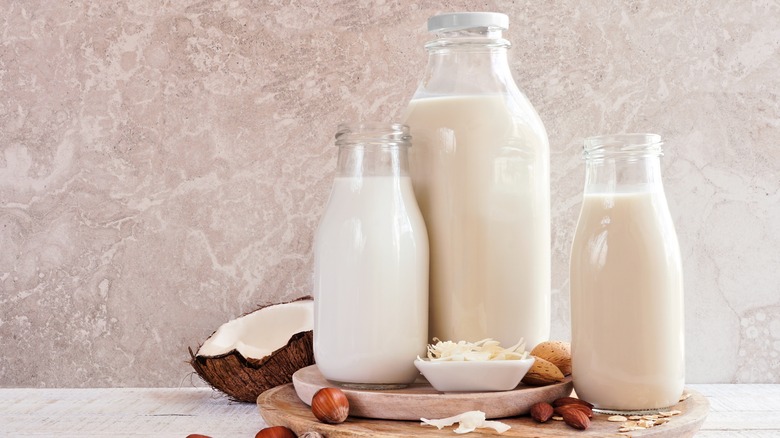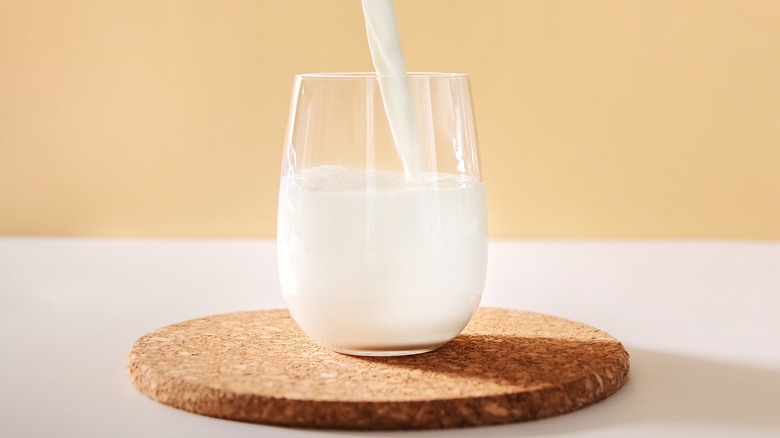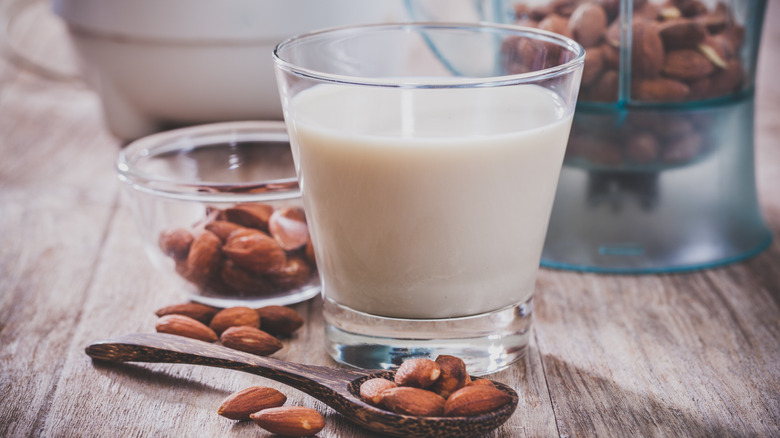What's The Difference Between Almond Milk And Coconut Milk?
Most of us grew up drinking cow's milk; in fact, 30 years ago, Americans drank 0.78 cups of dairy milk per day (about 18 gallons per year), but that amount dropped to just 0.49 cups per day (about 11 gallons per year) in 2019, according to the U.S. Department of Agriculture (USDA). What happened? The increase in dairy-free milk options is a big reason, according to a 2020 USDA report. Concern about animal welfare is another, per The New York Times.
If you have decided that cow's milk is not for you, whether you have a soft spot for cows, are allergic or lactose intolerant, or just want to make a change for taste or your health, there are dozens of plant-based milks to choose from (per Everyday Health) Two popular options are almond milk and coconut milk. What's the difference between almond milk and coconut milk? And which one is right for you?
Both plant-based milks are delicious, are great to drink straight, and work well in most recipes. Both choices are lactose-free and vegan. But how do you choose?
The differences between almond milk and coconut milk
What we choose to put on our plate (or in our glass) depends on several factors. Let's start with taste and texture. Almond milk tastes sweet and, well, slightly nutty, according to The Kitchn. While the mouthfeel is creamy, it isn't as thick as dairy milk. Coconut milk has a sweet taste and a rich texture, according to Eater. Whichever one you choose, shake the carton before you pour, says Huffpost, since some solids can settle at the bottom during storage. Just think of it as an upper arm workout.
Almond milk is the most popular plant-based milk in the U.S., followed by oat, soy, and coconut, according to Statista. All are readily available. Popular almond milk brands include Three Trees Organics and Elmhurst.
Aside from flavor and popularity, there are differences in nutrition, per Diffen. Per 100 grams, sweetened almond milk has 17 calories, while coconut milk can range from 154 to 230 calories. There is almost no saturated fat in almond milk, but coconut milk has almost 19 grams per cup. Almond milk has 188 mg of calcium, versus coconut milk's 16 mg. And almond milk has 0.42 grams of protein per 100 grams, while coconut milk has 2.29 grams. Think about what's important to you when you buy.
Can I make my own almond milk or coconut milk?
Making your own milk from almonds or coconut takes a bit of time, but it's not difficult. You just need whole almonds or coconut flakes, a high-speed blender or food processor, some cheesecloth (or an appropriately-named nut milk bag), and bottles or containers to store it.
Buy raw, unsalted almonds to make almond milk, according to Go Dairy Free. ("Raw" almonds aren't really raw since they have been pasteurized to kill pathogens, according to NPR.) Start by soaking the almonds overnight in water in the refrigerator. The next day, drain the almonds, discard the liquid, and transfer them to the blender or food processor. Add more water, then process for at least one minute, strain the mixture, and refrigerate. You can also try adding sweeteners like date and honey to your almond milk.
The process is the same for coconut milk, except you don't soak the coconut first, per the Kitchn. Just combine unsweetened shredded coconut with water in the blender, blend, and strain. You can flavor either milk with extracts or additions like cocoa powder, vanilla, fruits, or spices.
Now that you have your homemade plant-based milk (or cartons in the fridge), enjoy it straight, pour it into your morning coffee or tea, or use it in recipes such as coconut mango ice cream, mashed sweet potatoes with coconut milk and chives, beef rendang, or a banana almond milk and matcha smoothie. Yum.


